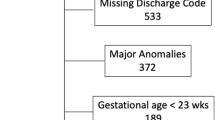Abstract
Objective
To test the non-inferiority of an alternative to the Apgar score.
Study design
The Neonatal Resuscitation and Adaptation Score (NRAS) was recorded in parallel to the Apgar score by a resuscitation team at deliveries. Correlation between the systems was assessed, as well as the predictive ability of NRAS and Apgar scores for mortality or short-term morbidities.
Results
A total of 340 infants were in the study group. The two scores correlated strongly (r = 0.87 and 0.83 at 1 and 5 min, respectively). Those needing ventilation at 48 h of life had a 5-min NRAS < 7 in 23/26 vs Apgar < 7 (23/36, p = 0.001). A low (0–3) 1-min NRAS score was more predictive of death, 53% vs 17%, p = 0.0065.
Conclusions
NRAS correlates with Apgar status assessment, and identifies newborns who die or may require further care better than the Apgar score.
This is a preview of subscription content, access via your institution
Access options
Subscribe to this journal
Receive 12 print issues and online access
$259.00 per year
only $21.58 per issue
Buy this article
- Purchase on Springer Link
- Instant access to full article PDF
Prices may be subject to local taxes which are calculated during checkout


Similar content being viewed by others
Change history
19 September 2018
Since the publication of the above article, the authors have noted that the name of the first Item in the NRAS scoring system in Figure 1 was omitted. It is Heart Rate (C1). The authors apologise for any inconvenience caused by this error. The html and online pdf versions have now been rectified and carry the corrected Figure.
References
Apgar V. A proposal for a new method of evaluation of the newborn infant. Curr Res Anesth Analg. 1953;32:260–7.
American Academy of Pediatrics Committee on Fetus and Newborn; American College of Obstetricians and Gynecologists Committee on Obstetric Practice. The Apgar score. Pediatrics. 2015;136:819–22.
Wyckoff MH, Aziz K, Escobedo MB, Kapadia VS, Kattwinkel J, Perlman JM, et al. Part 13: Neonatal Resuscitation: 2015 American Heart Association guidelines update for cardiopulmonary resuscitation and emergency cardiovascular care. Circulation. 2015;132:S543–S560.
O’Donnell CP, Kamlin CO, Davis PG, Carlin JB, Morley CJ. Interobserver variability of the 5-minute Apgar score. J Pediatr. 2006;149:486–9.
Hegyi T, Carbone T, Anwar M, Ostfeld B, Hiatt M, Koons A, et al. The Apgar score and its components in the preterm infant. Pediatr. 1998;101:77–81.
Bashambu MT, Whitehead H, Hibbs AM, Martin RJ, Bhola M. Evaluation of interobserver agreement of Apgar scoring in preterm infants. Pediatrics. 2012;130:e982–7.
Drage JS, Kennedy C, Schwarz BK. The Apgar score as an index of neonatal mortality. A report from the collaborative study of cerebral palsy. Obstet Gynecol. 1964;24:222–30.
Drage JS, Kennedy C, Berendes H, Schwarz BK, Weiss W. The Apgar score as an index of infant morbidity. A report from the collaborative study of cerebral palsy. Dev Med Child Neurol. 1966;8:141–8.
Jurdi SR, Jayaram A, Sima AP, Hendricks Muñoz KD. Evaluation of a comprehensive delivery room neonatal resuscitation and adaptation score (NRAS) compared to the Apgar score: a pilot study. Glob Pediatr Health. 2015;2:2333794X15598293.
Rüdiger M, Braun N, Aranda J, Aguar M, Bergert R, Bystricka A. et al. Neonatal assessment in the delivery room: Trial to Evaluate a Specified Type of Apgar (TEST-Apgar). BMC Pediatr. 2015;15:18
Basu P, Som S, Choudhuri N, Das H. Contribution of the blood glucose level in perinatal asphyxia. Eur J Pediatr. 2009;168:833–8.
Christensen RD, Baer VL, Yaish HM. Thrombocytopenia in late preterm and term neonates after perinatal asphyxia. Transfusion. 2015;55:187–96.
Engle WD, Rosenfeld CR. Neutropenia in high-risk neonates. J Pediatr. 1984;105:982–6.
Moster D, Lie RT, Irgens LM, Bjerkedal T, Markestad T. The association of Apgar score with subsequent death and cerebral palsy: a population-based study in term infants. J Pediatr. 2001;138:798–803.
Kasdorf E, Laptook A, Azzopardi D, Jacobs S, Perlman JM. Improving infant outcome with a 10 min Apgar of 0. Arch Dis Child Fetal Neonatal Ed. 2015;100:F102–F105.
Wennergen M, Krantz M, Hjalmarson O, Karlsson K. Low Apgar score as a risk factor for respiratory disturbances in the newborn infant. J Perinat Med. 1987;15:153–60.
Casey BM, McIntire DD, Leveno KJ. The continuing value of the Apgar score for the assessment of newborn infants. N Engl J Med. 2001;344:467–71.
Li F, Wu T, Lei X, Zhang H, Mao M, Zhang J. The Apgar score and infant mortality. PLoS ONE. 2013;8:e69072.
Apgar V, James LS. Further observations on the newborn scoring system. Am J Dis Child. 1962;104:419–28.
Catlin EA, Carpenter MW, Brann BS IV, Mayfield SR, Shaul PW, Goldstein M, et al. The Apgar score revisited: influence of gestational age. J Pediatr. 1986;109:865–8.
American Academy of Pediatrics, Committee on Fetus and Newborn; American College of Obstetricians and Gynecologists and Committee on Obstetric Practice. The Apgar score. Pediatrics. 2006;117:1444–7.
Dalili H, Sheikh M, Hardani AK, Nili F, Shariat M, Nayeri F. Comparison of the combined versus conventional Apgar scores in predicting adverse neonatal outcomes. PLoS ONE. 2016;11:e0149464.
Author information
Authors and Affiliations
Corresponding author
Ethics declarations
Conflict of interest
The authors declare that they have no conflict of interest.
Rights and permissions
About this article
Cite this article
Witcher, T.J., Jurdi, S., Kumar, V. et al. Neonatal Resuscitation and Adaptation Score vs Apgar: newborn assessment and predictive ability. J Perinatol 38, 1476–1482 (2018). https://doi.org/10.1038/s41372-018-0189-5
Received:
Revised:
Accepted:
Published:
Issue Date:
DOI: https://doi.org/10.1038/s41372-018-0189-5



